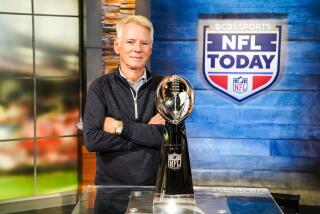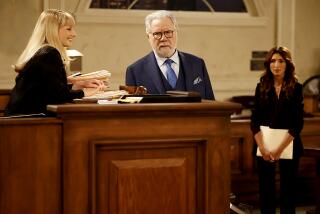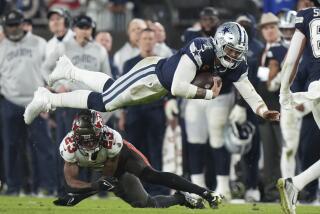Handing Off a Super Audience : Television: New series that follow the big game have a chance to score big--or fumble badly--out of the coveted position.
- Share via
It’s easy to see why producer Bill L. Norton was ecstatic when CBS executives informed him that his comedy/action series “Grand Slam” would debut after Sunday’s Super Bowl: The National Football League championship game is television’s most-watched event nearly every year.
“I was doing back flips when they told me they’d give us that slot. More people will see this piece of work that everything I’ve done in my career combined,” said Norton, whose credits include co-executive producing the first season of “Tour of Duty” and directing the movies “Baby . . . Secret of the Lost Legend” and “More American Graffiti.” “The time slot following the Super Bowl is the premier spot for introducing a new series on television.”
The fact is, however, that even with the promotional push of the Super Bowl, series that premiere after the big game are not a shoo-in for success.
Indeed, of the seven new series that have followed past Super Bowls, only three were renewed for the following season, with just two--”The A-Team” and “The Wonder Years”--becoming certified hits.
The practice of using the Super Bowl to introduce new series began in January, 1979. “Animal House” had been a surprise box-office movie hit the previous summer and all three networks ordered television imitations into production. NBC, then the third-place network and seeking a hit of any type, attempted to give its version, “Brothers and Sisters,” a leg up on the competition by scheduling its premiere after Super Bowl XIII.
“We didn’t have that many good time periods then and the slot after the Super Bowl was an important time slot for us,” then-NBC President Fred Silverman recalled. “The problem was that ‘Brothers and Sisters’ was a teen-age show and people who watched the Super Bowl wouldn’t watch ‘Brothers and Sisters.’ ”
The first “Brothers and Sisters” ranked only 28th in the weekly ratings and quickly foundered on its own, dropping to 51st with its second broadcast. It was cancelled that spring.
“ ‘Brothers and Sisters’ was a terrible show,” Silverman said. “The audience has radar that they can sniff out the real dogs.”
The next use of the Super Bowl to promote a series came in 1983 when NBC, still seeking to emerge from its third-place status, revived the strategy to benefit “The A-Team.” The series was scheduled to run from 8-9 p.m. Tuesday nights in a time period that had been dominated since 1975 by ABC’s “Happy Days” and “Laverne & Shirley.”
NBC rolled out the series with a pair of two-hour versions on consecutive Sundays. The week before the Super Bowl, “The A-Team” received a 23 rating, then got a 26.4 after the Super Bowl. “The A-Team” went on to finish the 1982-83 season tied for 10th in the seasonlong ratings, the highest finish by an NBC show in two years.
“That’s the kind of thing you hope happens--that once people are exposed to something, they’ll come back to it and the show will have a lasting effect on your program lineup,” observed Peter Tortorici, senior vice president of program planning at CBS.
However, the same results could not be repeated the next four years. CBS programmed “Airwolf” following the 1984 Super Bowl; it survived until the 1985-86 season. “MacGruder & Loud” (ABC, 1985), “The Last Precinct” (NBC, 1986) and “Hard Copy” (CBS, 1987, unrelated to currently syndicated “Hard Copy”) found even less success, with each show failing to be renewed for a full season.
In 1988, ABC ran “The Wonder Years” after the Super Bowl, a series that went on to finish in a 10th-place tie in the seasonlong ratings and won the Emmy for best comedy series. But Neal Marlens, the show’s co-creator and former executive producer, gives the Super Bowl tie-in little credit for the series’ success.
“In some ways it may have hurt us,” Marlens said. “We got a ton of promotion, but it was a good two months before we debuted on a regular basis. (Then) we got somewhat less promotion than other shows premiering in March.”
Marlens also believes that “The Wonder Years” would have been seen by nearly the same amount of viewers had it debuted in its normal time slot.
“By the fourth quarter, it was probably the lowest-rated Super Bowl,” Marlens said, recalling the Washington Redskins’ 42-10 win in Super Bowl XXII.
Former network programmer Silverman, now co-executive producer of such shows as “Jake and the Fatman” and “Matlock,” believes the very nature of the Super Bowl telecast can often work against the show following it.
“If you took a stopwatch and counted from the end of the football game to the (next) show, with commercials and the post-game show, it’ll be a good 25-30 minutes,” Silverman said. “With remote control, that’s an eternity. You’ve given the audience an enormous chance to turn elsewhere.”
CBS’ Tortorici said he began thinking about what to program after Sunday’s game a year-and-a-half ago.
The first step of the process was to determine the game’s starting time, which in turn controls how much of the night’s prime-time schedule would be left for the entertainment division. (The Super Bowl’s starting time is set by the National Football League, after consultation with the sports department of the network carrying the game.)
The next step was deciding what type of viewer to appeal to with the post-Super Bowl show.
“The Super Bowl attracts all kinds of viewers,” Tortorici said. “Men aren’t the only ones watching. You don’t get ratings in the 40s and 50s without women and kids.
“We thought something with good young and male appeal made sense to us because they would be there for us. We’ve had trouble reaching them with our regular programming lineup.”
“Grand Slam,” originally set to be a made-for-television movie, fit that bill. John Schneider and Paul Rodriguez star as competing bounty hunters.
“When we saw the dailies (raw footage of the scenes filmed the previous day), we told them to get scripts ready,” Tortorici said. “We saw this as a sensational series.”
Norton said that he had had discussions as early as last June about the show getting the coveted post-Super Bowl time slot for its debut. The only roadblock came when CBS Entertainment President Kim LeMasters resigned last Nov. 30, and the network had trouble finding a replacement.
But when Jeff Sagansky agreed a few weeks later to become LeMasters’ successor, one of his first decisions was to approve “Grand Slam” as the program to follow the Super Bowl. It will air immediately after the game in the Eastern and Central time zones, but because the game will end at an earlier hour on the West Coast, “Grand Slam” won’t be seen here until 7:30 p.m. (Channels 2 and 8), after the news. The series will thereafter be seen Wednesdays at 8 p.m.
Now, advises Marlens, the people involved with “Grand Slam” should sit back and hope for a close game that will keep the audience watching right through to the end.
“Hope that one team doesn’t score 35 points in the second quarter,” Marlens said, referring to the Redskins’ feat in Super Bowl XXII. “The key is to be thankful that there will be a significant audience for your first show, but don’t assume that’s going to be the key to success to the whole show.
“It’s like any large promotional push. It’s helpful and nice to get that for your show, but if your show’s bad, just more people will know your show’s not worth watching.”
More to Read
The complete guide to home viewing
Get Screen Gab for everything about the TV shows and streaming movies everyone’s talking about.
You may occasionally receive promotional content from the Los Angeles Times.






